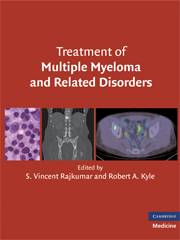Book contents
- Frontmatter
- Contents
- List of Contributors
- 1 DIAGNOSIS AND GENETIC CLASSIFICATION OF MULTIPLE MYELOMA
- 2 STAGING AND RISK-STRATIFICATION OF MULTIPLE MYELOMA
- 3 TREATMENT OF NEWLY DIAGNOSED MULTIPLE MYELOMA
- 4 MAINTENANCE THERAPY IN MULTIPLE MYELOMA
- 5 TREATMENT OF RELAPSED AND RELAPSED/REFRACTORY MULTIPLE MYELOMA
- 6 DIAGNOSIS AND TREATMENT OF MYELOMA BONE DISEASE
- 7 TREATMENT OF MYELOMA-RELATED COMPLICATIONS
- 8 AUTOLOGOUS TRANSPLANTATION FOR MULTIPLE MYELOMA
- 9 ALLOGENEIC STEM CELL TRANSPLANTATION FOR MULTIPLE MYELOMA
- 10 IMMUNOGLOBULIN LIGHT CHAIN AMYLOIDOSIS
- 11 WALDENSTRÖM MACROGLOBULINEMIA/LYMPHOPLASMACYTIC LYMPHOMA
- 12 DIAGNOSIS, RISK-STRATIFICATION, AND MANAGEMENT OF SOLITARY PLASMACYTOMA
- 13 MONOCLONAL GAMMOPATHY OF UNDETERMINED SIGNIFICANCE AND SMOLDERING MULTIPLE MYELOMA
- 14 DIAGNOSIS AND TREATMENT OF POEMS SYNDROME
- Index
- References
5 - TREATMENT OF RELAPSED AND RELAPSED/REFRACTORY MULTIPLE MYELOMA
Published online by Cambridge University Press: 11 July 2009
- Frontmatter
- Contents
- List of Contributors
- 1 DIAGNOSIS AND GENETIC CLASSIFICATION OF MULTIPLE MYELOMA
- 2 STAGING AND RISK-STRATIFICATION OF MULTIPLE MYELOMA
- 3 TREATMENT OF NEWLY DIAGNOSED MULTIPLE MYELOMA
- 4 MAINTENANCE THERAPY IN MULTIPLE MYELOMA
- 5 TREATMENT OF RELAPSED AND RELAPSED/REFRACTORY MULTIPLE MYELOMA
- 6 DIAGNOSIS AND TREATMENT OF MYELOMA BONE DISEASE
- 7 TREATMENT OF MYELOMA-RELATED COMPLICATIONS
- 8 AUTOLOGOUS TRANSPLANTATION FOR MULTIPLE MYELOMA
- 9 ALLOGENEIC STEM CELL TRANSPLANTATION FOR MULTIPLE MYELOMA
- 10 IMMUNOGLOBULIN LIGHT CHAIN AMYLOIDOSIS
- 11 WALDENSTRÖM MACROGLOBULINEMIA/LYMPHOPLASMACYTIC LYMPHOMA
- 12 DIAGNOSIS, RISK-STRATIFICATION, AND MANAGEMENT OF SOLITARY PLASMACYTOMA
- 13 MONOCLONAL GAMMOPATHY OF UNDETERMINED SIGNIFICANCE AND SMOLDERING MULTIPLE MYELOMA
- 14 DIAGNOSIS AND TREATMENT OF POEMS SYNDROME
- Index
- References
Summary
INTRODUCTION
Despite recent advances in therapy, relapsed and refractory multiple myeloma (MM) remains a significant challenge and an area of unmet medical need. Median survival and responses to treatment are characteristically short. Relapsed and refractory MM is defined as patients who achieve at least a minor response (MR) or better followed by relapse and then progress on salvage therapy, or experience progression within 60 days of their last therapy. Successive treatment regimens typically result in progressively shorter response durations, which reflects emerging drug resistance. The observed decrease in response duration may also reflect changes in disease biology within each patient, with tumor cells expressing a more aggressive phenotype, higher proliferative thrust, and lower apoptotic rates.
Although several prognostic factors have been identified for newly diagnosed myeloma, factors that retain prognostic value in the context of relapsed/refractory disease remain to be comprehensively defined. Nonetheless, patients with poor risk include those with t(4;14) or t(14;16), deletion 17 or deletion 13, hypodiploidy, high- β2-microglobulin, light-chain disease, immunoglobulin A (IgA) isotype, and low serum albumin; clinical challenges in the relapsed/refractory population include renal failure, extramedullary disease, hyposecretory myeloma, and advanced bone disease.
The advent of novel therapies targeting disease biology and tumor microenvironment has significantly improved the prognosis for patients with relapsed and refractory disease. Bortezomib, a first-in-class proteasome inhibitor, and the immunomodulatory agents thalidomide (Thal) and lenalidomide now constitute “backbone” agents in this setting.
- Type
- Chapter
- Information
- Treatment of Multiple Myeloma and Related Disorders , pp. 46 - 63Publisher: Cambridge University PressPrint publication year: 2008



